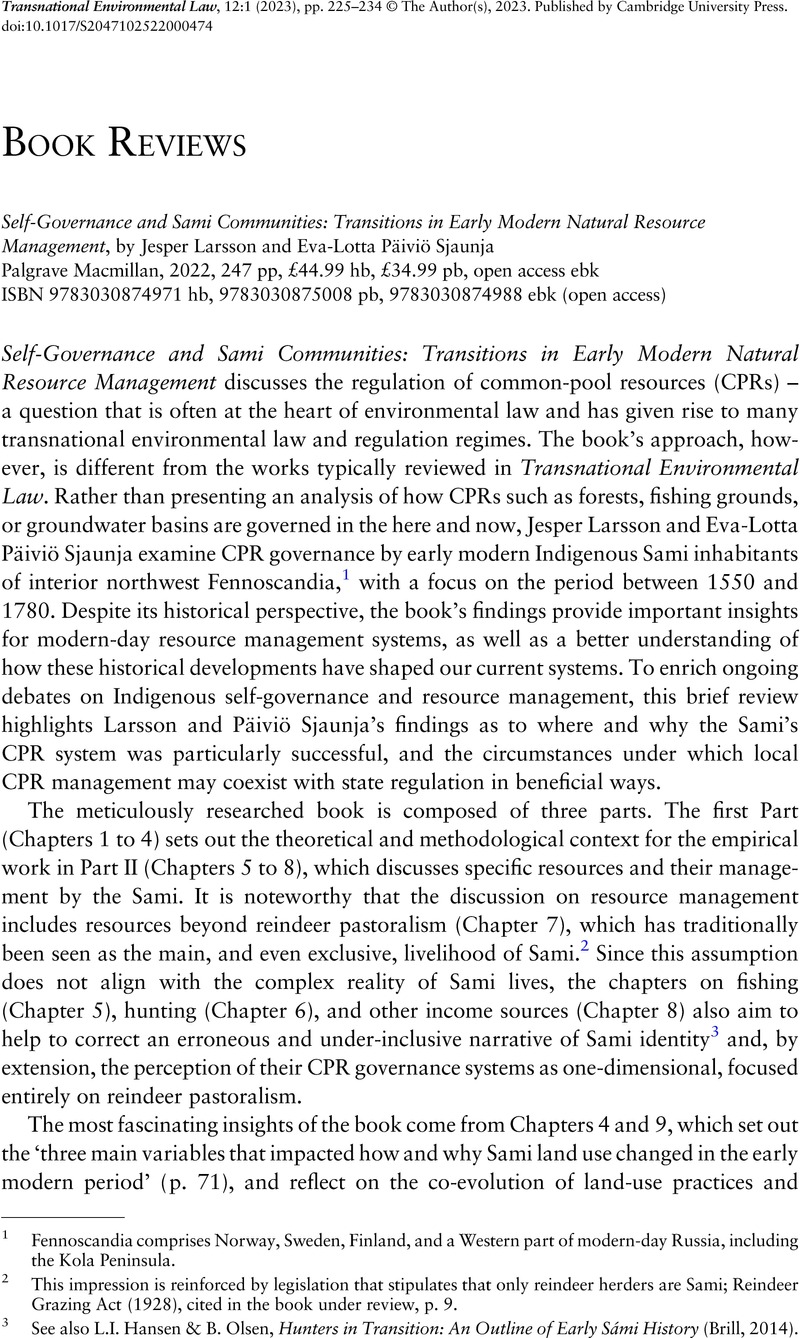No CrossRef data available.
Article contents
Self-Governance and Sami Communities: Transitions in Early Modern Natural Resource Management, by Jesper Larsson and Eva-Lotta Päiviö Sjaunja Palgrave Macmillan, 2022, 247 pp, £44.99 hb, £34.99 pb, open access ebk ISBN 9783030874971 hb, 9783030875008 pb, 9783030874988 ebk (open access)
Review products
Published online by Cambridge University Press: 14 February 2023
Abstract

- Type
- Book Reviews
- Information
- Copyright
- Copyright © The Author(s), 2023. Published by Cambridge University Press
References
1 Fennoscandia comprises Norway, Sweden, Finland, and a Western part of modern-day Russia, including the Kola Peninsula.
2 This impression is reinforced by legislation that stipulates that only reindeer herders are Sami; Reindeer Grazing Act (1928), cited in the book under review, p. 9.
3 See also Hansen, L.I. & Olsen, B., Hunters in Transition: An Outline of Early Sámi History (Brill, 2014)CrossRefGoogle Scholar.
4 Österberg, E., Lennartsson, M. & Næss, H. Eyvind, ‘Social Control Outside or Combined with the Secular Judicial Arena’, in Österberg, E. & Sogner, S. Bauge, People Meet the Law (Oslo Universitetsforlaget, 2000), pp. 237–66Google Scholar.
5 See also Korpiola, M., ‘Not Without the Consent and Goodwill of the Common People’ (2014) 35(2) The Journal of Legal History, pp. 95–119CrossRefGoogle Scholar.
6 It must be noted that in criminal and religious cases, the Swedish state's view prevailed over local traditions and customs. The division of influence as described here was specific to cases related to the management of natural resources.
7 There is also an important parallel here with Vincent Ostrom's work on polycentric, and ultimately self-governing, societies, which – in his view – should be seen as symbiotic with the state rather than a rejection of state governance: Ostrom, V., The Meaning of Democracy and the Vulnerability of Democracies: A Response to Tocqueville's Challenge (University of Michigan Press, 1997)CrossRefGoogle Scholar.
8 See Zeben, J. van, ‘Facing the Legitimacy Challenge: Law as a Disciplining Force for Transnational Environmental Governance’, in Heyvaert, V. & Duvic-Paoli, L.-A., Research Handbook on Transnational Environmental Law (Edward Elgar, 2020), pp. 145–59CrossRefGoogle Scholar.
9 On environmental justice generally, see Schlosberg, D. & Collins, L.B., ‘From Environmental to Climate Justice: Climate Change and the Discourse of Environmental Justice’ (2014) 5(3) WIREs Climate Change, pp. 359–74CrossRefGoogle Scholar; on tensions between environmentalism and justice, see Sandler, R. & Pezzullo, P.C. (eds), Environmental Justice and Environmentalism: The Social Justice Challenge to the Environmental Movement (The MIT Press, 2007)CrossRefGoogle Scholar.
10 New York, NY (US), 9 May 1992, in force 21 Mar. 1994, available at: https://unfccc.int/resource/docs/convkp/conveng.pdf.
11 Comberti, C. et al., ‘Adaptation and Resilience at the Margins: Addressing Indigenous Peoples' Marginalization at International Climate Negotiations’ (2019) 61(2) Environment: Science and Policy for Sustainable Development, pp. 14–30Google Scholar.
12 See, in detail, Ostrom, E., Understanding Institutional Diversity (Princeton University Press, 2005)Google Scholar; Ostrom, R., Gardner, R. & Walker, J., Rules, Games, and Common-Pool Resources (University of Michigan Press, 1993)Google Scholar.


